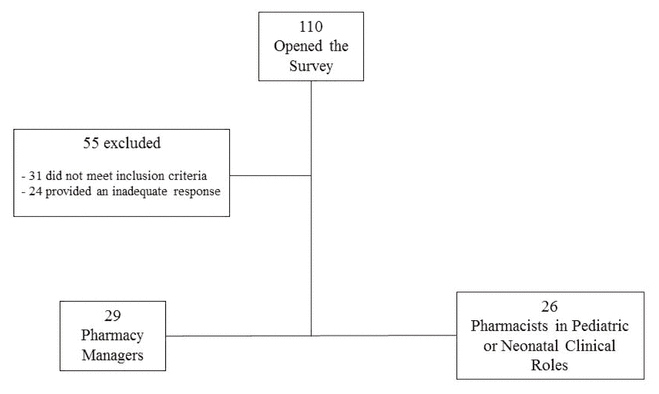
Figure 1 Responses to a web-based survey of pharmacy staff in Canadian adult hospitals. Responses that were excluded from further analysis did not meet the inclusion criteria or were inadequate for analysis.
Amanda Burns, Leslie Manuel, Andrew Dickie, Jennifer BesseyABSTRACT
Background
The rate of potential adverse drug events is reported to be 3 times higher among pediatric inpatients than among their adult counterparts. Various methods have been suggested to reduce medication errors in pediatric patients. One of the most influential of these strategies is inclusion of a clinical pharmacist on the multidisciplinary care team. However, there is currently no literature describing the inventory of pharmacy services provided to pediatric patients in Canadian adult hospitals.
Objectives
The primary objective of this study was to describe pediatric and neonatal pharmacy services provided in adult hospitals in Canada. The secondary objective was to determine whether the services provided correspond to services that pharmacists working in Canadian pediatric hospitals identified as important for adult hospitals that provide pediatric services.
Methods
Two web-based surveys were created, focusing on 35 pharmacy services. The first survey was intended for adult hospitals, and the second for pediatric hospitals. The surveys were distributed by e-mail and were completed in January and February 2018.
Results
A total of 55 and 43 valid responses were received from respondents in adult hospitals and pediatric hospitals, respectively. An inventory of pharmacy services provided by adult hospitals to their pediatric and neonatal patients was obtained. Of the adult hospitals that responded, 61% (33/54) had pharmacists assigned to pediatric or neonatal units. The frequency with which most pharmacy services were provided was comparable to the importance identified by pharmacists working in pediatric hospitals. However, for the provision of education during admission and at discharge and for the provision of medication reconciliation at discharge, frequency and importance were not comparable.
Conclusions
Adult hospitals with a pharmacist assigned to an inpatient pediatric or neonatal clinical area met most expectations of pharmacists working in pediatric hospitals in terms of pharmacy services provided. However, some services require optimization for this patient population.
KEYWORDS: pediatric patients, neonate/neonatal, pediatric pharmacy services, pharmacists, Canada, adult hospitals, pediatric hospitals
RÉSUMÉ
Contexte
On rapporte que le taux de réactions indésirables potentielles aux médicaments est trois fois plus élevé chez les enfants hospitalisés que chez les adultes. Diverses méthodes ont été proposées pour réduire les erreurs de médication chez les patients pédiatriques. L’une des stratégies les plus influentes consiste à inclure un pharmacien clinique au sein de l’équipe de soins pluridisciplinaire. Cependant, il n’existe actuellement aucun document dressant l’inventaire des services de pharmacie offerts aux patients pédiatriques dans les hôpitaux canadiens pour adultes.
Objectifs
L’objectif principal de cette étude consistait à décrire les services de pharmacie pédiatriques et néonataux offerts dans les hôpitaux pour adultes au Canada. L’objectif secondaire consistait quant à lui à déterminer si les services offerts à la population pédiatrique dans les hôpitaux pour adultes correspondaient à ceux que les pharmaciens travaillant dans les hôpitaux pédiatriques canadiens reconnaissaient comme étant importants.
Méthodes
Deux sondages en ligne se focalisant sur 35 services de pharmacie ont été créés. Le premier était destiné aux hôpitaux pour adultes et le deuxième aux hôpitaux pédiatriques. Les sondages ont été distribués par courriel et effectués en janvier et février 2018.
Résultats
Cinquante-cinq (55) répondants des hôpitaux pour adultes et 43 des hôpitaux pédiatriques y ont répondu en bonne et due forme. Les investigateurs ont obtenu en outre la liste des services de pharmacie offerts par les hôpitaux pour adultes à leurs patients pédiatriques et néonataux. Soixante et un pour cent (61 %), soit 33 sur 54, des répondants provenant des hôpitaux pour adultes à étaient des pharmaciens affectés aux unités pédiatriques ou néonatales. La fréquence de l’offre de la majorité des services de pharmacie était d’importance comparable à ce que les pharmaciens travaillant dans les hôpitaux pédiatriques ont relevé. Toutefois, pour ce qui est des instructions données au patient à l’admission et au congé et de la prestation du bilan des médicaments au congé, la fréquence et l’importance de ces services n’étaient pas comparables.
Conclusions
Les hôpitaux pour adultes disposant d’un pharmacien affecté à un domaine clinique pédiatrique ou néonatal répondaient à la plupart des attentes des pharmaciens travaillant dans les hôpitaux pédiatriques en termes d’offre de services de pharmacie. Cependant, certains services demandent à être optimisés pour cette population de patients.
MOTS CLÉS: patients pédiatriques, nouveau-nés/néonatal, services de pharmacie pédiatrique, pharmaciens, Canada, hôpitaux pour adultes, hôpitaux pédiatriques
The pediatric population is a vulnerable group, especially when receiving medications, with multiple contributing factors. As a child develops, there are ongoing changes to body composition and physiology, which can affect pharmacokinetic parameters, such as absorption, distribution, metabolism, and excretion. In addition, most dosing is based on patient-specific calculations using weight, age, or body surface area.1 Numerous medications are unavailable in suitable child-friendly formulations and strengths, which results in the need to manipulate dosage forms. These factors contribute to an increased risk of pediatric patients being exposed to a 10-fold or greater medication error.1
Kaushal and others2 found that the rate of medication errors, adverse drug events (ADEs), and preventable ADEs in pediatric inpatients was similar to that reported for adult inpatients. However, the rate of potential ADEs—defined as medication errors with a significant potential to injure the patient—is reportedly 3 times higher in the pediatric population than in adults, and is substantially higher in neonates than in other age groups.2 Furthermore, neonates in the neonatal intensive care unit (NICU) are subject to a higher rate of medication errors and potential ADEs than neonates in other wards.2
The Joint Commission3 and the American Academy of Pediatrics4 have released guiding documents regarding the prevention of medication errors in pediatric inpatients. Among these risk-reduction recommendations is an emphasis on including a clinical pharmacist on the multidisciplinary care team.
Various methods have been suggested to assist in the reduction of medication errors. Fortescue and others5 analyzed 10 medication error-prevention strategies for pediatric inpatients. They determined that the presence of ward-based clinical pharmacists could have resulted in an 81.3% reduction in the rate of medication errors and could have prevented 88.3% of potentially harmful errors.5 In another study with similar results, physician reviewers judged that 94% of the potential ADEs and 4 of the 5 preventable ADEs could have been prevented by ward-based clinical pharmacists.2
Published studies have identified numerous benefits of pharmacist-led interventions for pediatric inpatients. For example, the presence of a clinical pharmacist in the pediatric intensive care unit can reduce the rate of serious medication errors by 79%.6 The most common intervention implemented by ward-based clinical pharmacists has consisted of changing drug dose regimens,7–9 given that most intercepted errors occurred at the physician ordering stage.6 Furthermore, increased presence of a clinical pharmacist in the pediatric intensive care unit was positively correlated with an increase in the number of interventions.8
The 2016/2017 Hospital Pharmacy in Canada Report published data on pediatric pharmacy services. The report provided information for both adult hospitals and pediatric hospitals. Among the adult hospitals with pediatric and/or neonatal critical care units that responded to the survey, 76% reported having an inpatient pharmacist assigned to these areas.10 However, this report did not capture details regarding the amount of pharmacist coverage or the type of services offered. Currently, there is no literature describing the inventory of pharmacy services provided to pediatric or neonatal patients within adult hospitals in Canada.
The primary objective of this study was to describe pediatric and neonatal pharmacy services provided in adult hospitals in Canada. The secondary objective was to determine whether the services provided correspond to services that pharmacists working in Canadian pediatric hospitals identified as important for adult hospitals that provide pediatric services.
We hypothesized that in adult hospitals with an assigned pediatric pharmacist, the services that are frequently provided would correspond to those with greater importance, as identified by pharmacists working in pediatric hospitals.
Canadian adult hospitals were identified through the websites of provincial and territorial health authorities. In addition, internet searches were performed to identify hospitals not affiliated with a provincial or territorial health authority. Each health authority or hospital was reached by telephone to obtain contact information for the pharmacy director, pharmacy manager, or an alternate contact, as appropriate. Adult hospitals were included in this study if their facilities had an inpatient pediatric unit or NICU. Within this population, pharmacy managers, designates of the pharmacy manager, or pharmacists in pediatric or neonatal clinical roles were invited to participate. Canadian pediatric hospitals were identified through the Canadian Association of Paediatric Health Centres11 and were reached by telephone to obtain contact information for their respective pharmacy managers. Within this population, pharmacists in a clinical role were invited to participate. This population was chosen as the reference, because these clinical pharmacists specialize in pediatrics and experience greater patient volume and acuity than pharmacists who care for pediatric patients in adult hospitals. Including their perspective may allow for greater understanding of the needs of this patient population.
An initial set of questions was developed to obtain an inventory of pharmacy services provided to pediatric and neonatal patients in adult hospitals. A second set of a similar number of questions was created to determine the importance rating of these pharmacy services according to pharmacists working in pediatric hospitals. Several aspects of the questions surrounding pharmacy services were adapted from relevant publications12,13 and from studies that investigated pharmacist-led interventions in pediatric inpatient units.7–9,14,15
Preliminary questions addressed information about the hospital respondents (e.g., type of hospital, total number of beds, total number of pharmacist full-time equivalents [FTEs], types of pediatric inpatient areas and corresponding number of beds, types of pediatric ambulatory care clinics, clinical pharmacist assignment and corresponding number of FTEs, and clinical pharmacy assistant/technician coverage and corresponding number of FTEs). The main section of each survey focused on 28 direct and 7 indirect patient care pharmacy services. In the survey of Canadian adult hospitals, participants were asked to identify how often the specified direct and indirect patient care pharmacy services were provided to pediatric and neonatal patients, according to a 5-point Likert scale, where the available options ranged from “never/not applicable” to “> once per day”. In the survey of pharmacists working in Canadian pediatric hospitals, participants were asked to rank the same specified direct and indirect patient care pharmacy services in terms of their importance to be provided by adult hospitals to their pediatric and neonatal populations, according to a 5-point Likert scale, where the available options ranged from “not important/never” to “very important”.
The surveys were initially distributed to a group of 5 pharmacists within Horizon Health Network, who assessed the appropriateness, comprehensiveness, clarity, and face validity of each survey. These 5 pharmacists were not excluded from participating in the survey, but they were not involved in survey administration or analysis of responses.
The web-based surveys were available in English and French through the online research survey platform LimeSurvey, version 2.73.1 (2017; https://www.limesurvey.org/). A signed consent form was not required, because the survey was anonymous. However, each survey contained an informed consent page that detailed the purpose of and participation in the research study. Completion of the survey was deemed to imply that the participant had given consent.
Each web-based survey was distributed by e-mail to the corresponding population of interest, through pharmacy directors and pharmacy managers, the Canadian Society of Hospital Pharmacists (CSHP), and the Association des pharmaciens des établissements de santé du Québec. Each survey was available for a 5-week period in January and February 2018. One reminder was sent by e-mail to each potential participant at the halfway point. This study was reviewed and approved by the Horizon Health Network Research Ethics Board on December 1, 2017.
Calculation of descriptive statistics, including means, standard deviations, and percentages, was the primary data analysis method. These measures were used to summarize hospital-related information, to describe the frequency with which pharmacy services were being provided by Canadian adult hospitals to their pediatric and neonatal populations, and to describe the importance ranking that pharmacists working in Canadian pediatric hospitals attributed to each given pharmacy service.
The unit of analysis for the survey of Canadian adult hospitals was the hospital itself. If more than one response was received from the same facility, the primary investigator determined which response was most relevant and merged the data when appropriate. The unit of analysis for the survey of Canadian pediatric hospitals was the individual clinical pharmacist.
A total of 55 valid responses were received from Canadian adult hospitals, which consisted of responses from 29 pharmacy managers and 26 pharmacists in pediatric or neonatal clinical roles (Figure 1). Representation from 9 provinces was achieved. The characteristics of these hospitals are presented in Table 1. Of the adult hospitals represented, 84% (46/55) were reported to have a general pediatric unit, and 69% (37/54) were reported to have a NICU. In terms of pharmacist assignment, 39% (21/54) of the adult hospitals were reported to have no pharmacist assigned to an inpatient pediatric or neonatal clinical area. The remaining 33 adult hospitals did have a pharmacist assigned to a pediatric or neonatal area: 50% (27/54) of all hospitals had pharmacists assigned to the NICU and 44% (24/54) had pharmacists assigned to the general pediatric unit. Among the 31 hospitals with pharmacists assigned to an inpatient pediatric unit that provided information about direct patient care, 11 (35%) reported that the pharmacists spent less than 25% of their day providing direct patient care, with 8 (26%) reporting that they spent more than 75% of their day providing direct patient care. This survey also collected information about the assignment of pharmacists to pediatric ambulatory care clinics. The majority (19/29 [66%]) of respondents from adult hospitals reported that no pharmacists were assigned to these areas. The remaining 10 adult hospitals did have a pharmacist assigned to pediatric ambulatory care clinics; the largest proportion of all respondents (7/29 [24%]) had a pharmacist assigned to a pediatric oncology clinic.
|
|
||
|
Figure 1 Responses to a web-based survey of pharmacy staff in Canadian adult hospitals. Responses that were excluded from further analysis did not meet the inclusion criteria or were inadequate for analysis. |
||
Table 1 Characteristics of Canadian Adult Hospitals*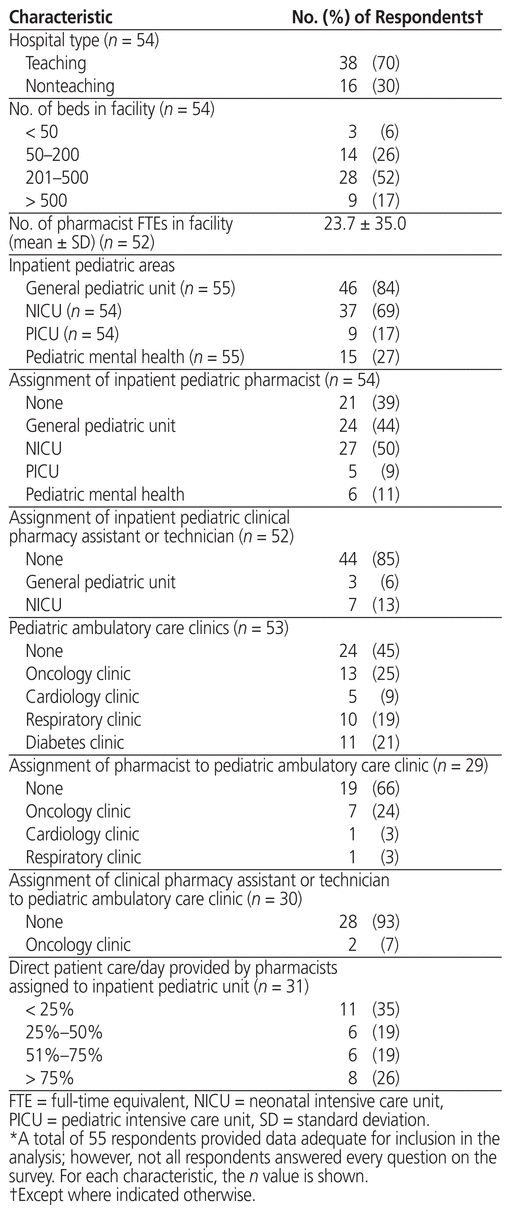
Overall, 33 (60%) of respondents from adult hospitals reported that no pharmacy learners completed experiential rotations in their pediatric or neonatal clinical areas. Of the 22 adult hospitals with pharmacy learners in these areas, 19 (86%) and 12 (55%) had pharmacist students and pharmacy residents, respectively. Other types of pharmacy learners identified included pharmacy technician students.
A total of 43 valid responses were received from pharmacists working in Canadian pediatric hospitals (Figure 2). Of the 7 provinces with pediatric hospitals, representation from 5 provinces was achieved. The practice characteristics of these pharmacists, including information about their hospital setting, are presented in Table 2. Overall, the majority of pharmacists working in a pediatric hospital reported practising in either the NICU, the pediatric intensive care unit, or a pediatric medical unit (12 [28%] each). In terms of direct patient care, nearly half (18 [42%]) reported spending 51%–75% of their day providing direct patient care.
|
|
||
|
Figure 2 Responses to a web-based survey of pharmacists working in Canadian pediatric hospitals. Responses that were excluded from further analysis did not meet the inclusion criteria or were inadequate for analysis. |
||
Table 2 Practice Characteristics of Pharmacists Working in Canadian Pediatric Hospitals*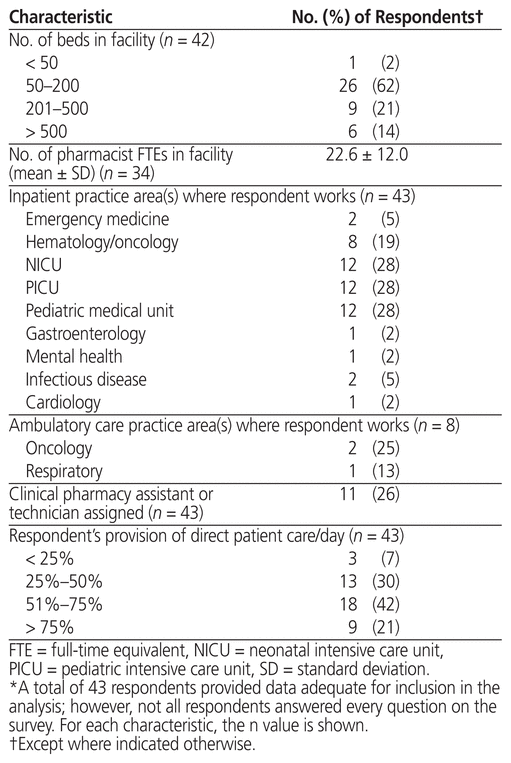
Nearly all pharmacists working in pediatric hospitals (42 [98%]) reported that pharmacy learners completed experiential rotations in their practice area. The majority reported the presence of pharmacist students and pharmacy residents (34 [79%] and 29 [67%], respectively). Other types of pharmacy learners identified included pharmacy technician students, PharmD students, and international students.
The Canadian adult hospitals with survey responses were further subdivided into the following 2 categories: adult hospitals with a pharmacist assigned to one or more inpatient pediatric or neonatal clinical areas and adult hospitals without any pharmacists assigned to such areas. The frequencies with which adult hospitals with and without assigned pharmacists provided direct and indirect patient care pharmacy services to their pediatric and neonatal patients are presented in Table 3.
Table 3 Frequency of Direct and Indirect Patient Care Pharmacy Services Provided by Canadian Adult Hospitals, with (n = 31) and without (n = 24) an Assigned Pharmacist, to Pediatric and Neonatal Patients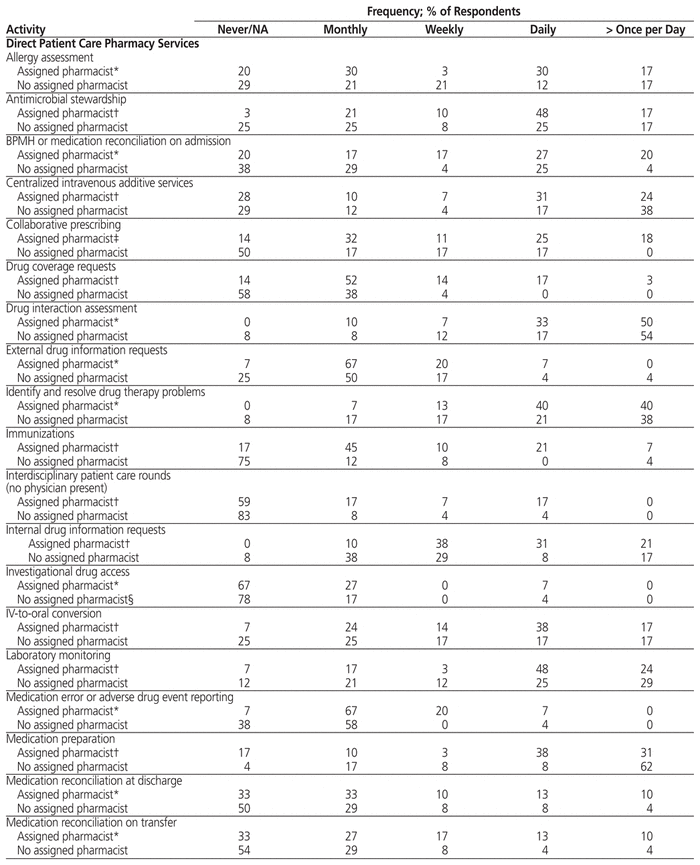
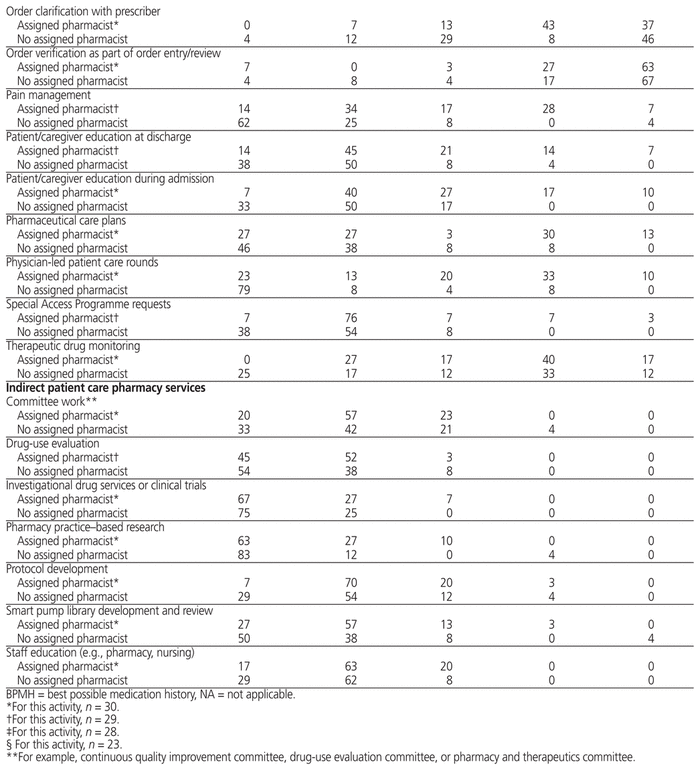
The importance ratings for direct and indirect patient care pharmacy services provided to pediatric and neonatal patients in adult hospitals, as ranked by pharmacists working in pediatric hospitals, are presented in Table 4.
Table 4 Importance Ratings among Pharmacists Working in Canadian Pediatric Hospitals (n = 43) for Direct and Indirect Patient Care Pharmacy Services Provided to Pediatric and Neonatal Patients in Canadian Adult Hospitals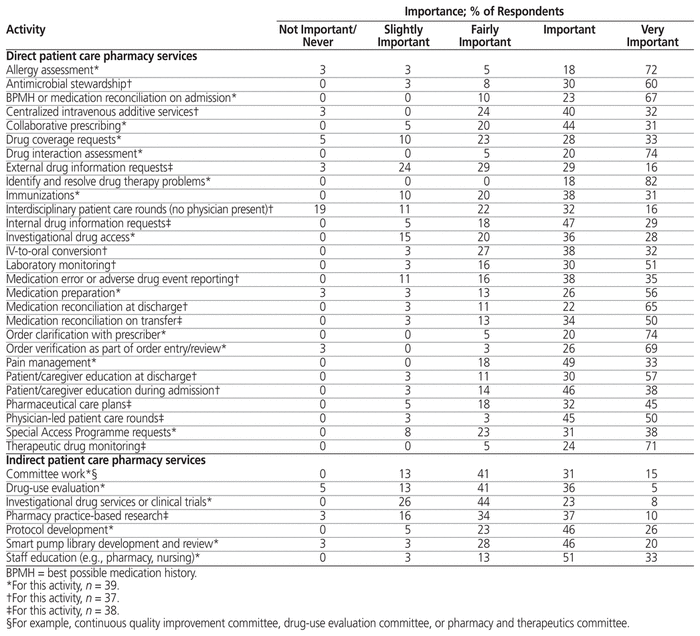
In adult hospitals with pharmacists assigned to an inpatient pediatric unit, respondents reported that certain pharmacy services, such as “drug interaction assessment” and “identify and resolve drug therapy problems”, were provided to their pediatric and neonatal populations more than once per day, whereas other pharmacy services, such as “medication reconciliation on admission”, “physician-led patient care rounds”, “therapeutic drug monitoring”, “laboratory monitoring”, and “IV-to-oral conversion”, were provided to their pediatric and neonatal populations daily. Interestingly, large proportions (nearly half ) of these respondents reported that educational pharmacy services (such as patient/caregiver education during admission and at discharge) were provided to their pediatric and neonatal populations only monthly. Furthermore, equal percentages of these respondents reported that “medication reconciliation at discharge” was never provided or not applicable or was provided only on a monthly basis.
The majority of pharmacists working in pediatric hospitals reported that certain pharmacy services, such as “medication reconciliation on admission”, “identify and resolve drug therapy problems”, “physician-led patient care rounds”, “therapeutic drug monitoring”, “medication reconciliation at discharge”, and “patient/caregiver education at discharge”, were very important services for adult hospitals to provide to their pediatric and neonatal populations.
Substantial proportions of respondents from adult hospitals with pharmacists assigned to an inpatient pediatric unit reported that some pharmacy services, such as “order clarification with prescriber”, “medication preparation”, and “centralized intravenous additive services”, were provided to their pediatric and neonatal populations daily; for other pharmacy services, such as “medication error or adverse drug event reporting” and “drug coverage requests”, the majority of respondents reported provision to their pediatric and neonatal populations monthly.
Substantial proportions of pharmacists working in pediatric hospitals reported that certain pharmacy services, such as “order clarification with prescriber”, “medication preparation”, and “drug coverage requests”, were very important services for adult hospitals to provide to their pediatric and neonatal populations, whereas other pharmacy services, such as “medication error or adverse drugevent reporting” and “centralized intravenous additive services”, were deemed to be important services to provide.
The majority of respondents from adult hospitals with pharmacists assigned to an inpatient pediatric unit reported that certain indirect patient care pharmacy services, such as “smart pump library development and review”, “protocol development”, and “staff education”, were completed monthly. Pharmacists working in pediatric hospitals identified these services as important for adult hospitals to provide to their pediatric and neonatal populations.
The proportion of adult hospitals with a pharmacist assigned to an inpatient pediatric or neonatal clinical area was comparable to that reported in the 2016/2017 Hospital Pharmacy in Canada Report10 (61% and 76%, respectively). The latter survey achieved a higher response rate, which may explain the discrepancy. This finding emphasizes that a number of adult hospitals remain without a pharmacist assigned to their pediatric and/or neonatal clinical areas. Therefore, patients in these areas are at greater risk of adverse drug events. The guidelines of the American Society of Health-System Pharmacists and the Pediatric Pharmacy Advocacy Group (ASHP-PPAG) recommend that clinical pharmacy services be prioritized to provide care to the highest-risk populations.16 In the context of resource limitations, the pharmacy department should aim to allocate a clinical pharmacist to areas such as critical care, neonatology, and the emergency department.
To the authors’ knowledge, this is the first study to establish an inventory of pharmacy services provided to pediatric and neonatal patients in Canadian adult hospitals. The frequency with which most pharmacy services were being provided by adult hospitals with an assigned pediatric pharmacist was comparable to the importance identified by pharmacists working in pediatric hospitals. Because our 2 surveys used different Likert scales (based on frequency versus importance), we are unable to draw any conclusions regarding correlation. However, when comparing the data reported for these pharmacy services, it is evident that adult hospitals providing clinical pediatric services met the expectations of pharmacists working in pediatric hospitals for the majority of direct patient care pharmacy services investigated (i.e., 25 of 28).
For 3 clinical pharmacy services, the frequency of provision in adult hospitals did not correspond to the importance identified by pharmacists working in pediatric hospitals: patient/caregiver education during admission and at discharge and medication reconciliation at discharge. The majority of pharmacists working in pediatric hospitals identified these pharmacy services as being important or very important for adult hospitals to provide to their pediatric and neonatal populations, but they were provided by adult hospitals with an assigned pediatric pharmacist at a reduced frequency relative to the identified importance. For these services, adult hospitals with an assigned pediatric pharmacist were not meeting the expectations of pharmacists working in pediatric hospitals.
The CSHP Excellence in Hospital Pharmacy survey recently reported similar findings for the general population.17 Of the patients surveyed, only 26% reported that they always received education from a hospital pharmacist before starting a new medication. Of the pharmacists surveyed, only 28% reported that more than 50% of their patients were receiving education during admission and at discharge. In addition, only 32% reported that medication reconciliation at discharge was provided to more than 50% of their patients.17
Interestingly, the provision of these pharmacy services is supported and promoted by various national organizations.13,16,18 For instance, the ASHP-PPAG guidelines state that “counseling of pediatric patients and their caregivers is an important role for the pharmacist.”16 The findings presented in this study further emphasize that these pharmacy services in particular need to be optimized for pediatric and neonatal populations receiving care within the adult hospital setting. An important point to consider when interpreting the above results is that these pharmacy services can be provided by other health care providers (i.e., non-pharmacists). It is plausible that provision of these pharmacy services was under-reported in the current study, as we did not ask participants to identify other health care providers who might have performed these tasks, if they themselves were not the ones primarily doing so.
An important area for consideration within the adult hospital setting is the fact that all pharmacists generally take call, which may include questions relating to pediatric patients. The ASHP-PPAG guidelines recommend that “the pharmacy department should provide adequate training for all staff members who may be called on to provide care to pediatric patients.”16 A pharmacist assigned to an inpatient pediatric or neonatal clinical area could play a significant role in achieving this recommendation. These pharmacists have invaluable experience and knowledge that could assist in educating other pharmacists to help ensure they are able to provide care to this patient population.
Several task-based pharmacy services were provided in adult hospitals with an assigned pediatric pharmacist at a frequency greater than expected, including “medication preparation” and “centralized intravenous additive services.” This may be suggestive of an additional role for the pharmacist in these patient care areas or may reflect an incorporated centralized role.
In this study, the majority (60%) of adult hospitals did not have pharmacy learners completing experiential rotations in their pediatric or neonatal clinical areas. This may, in part, be attributed to the fact that 39% of the adult hospitals did not have a pharmacist assigned to these areas. Pediatric hospitals are not accessible to all pharmacy learners because of their geographic distribution. Therefore, adult hospitals with inpatient pediatric or neonatal clinical areas could offer opportunities for pharmacy learners to gain experience with this patient population. The American College of Clinical Pharmacy and the Pediatric Pharmacy Advocacy Group have published recommendations supporting experiential education in the pediatric patient care setting.19 These organizations emphasized that this opportunity should be offered by all schools of pharmacy to promote the development of future pediatric pharmacists.
This study had several limitations. Unfortunately, we were unable to reach all eligible hospital pharmacy staff, and among those that we did reach, not all provided a response. For example, we did not receive any responses from children’s hospitals in British Columbia or Quebec. It is possible that pharmacy practice at these locations is significantly different from practice at sites for which responses were received. Therefore, the absence of responses from these provinces may have influenced the results. For the 3 pharmacy services for which importance and frequency of provision in adult hospitals did not correspond, it is important to recognize that the services could be provided by other health care professionals. Therefore, it is possible that these pharmacy services were under-reported in the current study. Finally, as with any survey, response bias may have influenced the results.
Several factors contribute to the strength of this study. It was a multisite study conducted across Canada, with a well-distributed survey response. The authors surveyed both adult hospitals and pediatric hospitals, which allowed for additional comparisons. Finally, this study contributes to closing the gap in knowledge surrounding pharmacy services that are currently being provided by adult hospitals to their pediatric and neonatal populations by generating an inventory of these services.
Adult hospitals with a pharmacist assigned to an inpatient pediatric or neonatal clinical area met most expectations of pharmacists working in pediatric hospitals in terms of provision of pharmacy services. This study identified 3 major pharmacy services—patient/caregiver education during admission and at discharge and medication reconciliation at discharge—that need to be optimized for pediatric and neonatal patients who are receiving care in adult hospitals in Canada. It is the authors’ hope that this study will increase awareness of the identified deficiencies and contribute to improved pharmaceutical care for this vulnerable population.
1 Promoting safety of medicines for children. Geneva (CH): World Health Organization; 2007 [cited 2017 Sep 14]. Available from: https://www.who.int/medicines/publications/essentialmedicines/Promotion_safe_med_childrens.pdf
2 Kaushal R, Bates DW, Landrigan C, McKenna KJ, Clapp MD, Federico F, et al. Medication errors and adverse drug events in pediatric inpatients. JAMA. 2001;285(16):2114–20.

3 Preventing pediatric medication errors. Sentinel Event Alert, issue 39. Oak Brook (IL): The Joint Commission; 2008 [cited 2017 Sep 14]. Available from: https://www.jointcommission.org/sentinel_event_alert_issue_39_preventing_pediatric_medication_errors/
4 Stucky ER; American Academy of Pediatrics Committee on Drugs; American Academy of Pediatrics Committee on Hospital Care. Prevention of medication errors in the pediatric inpatient setting. Pediatrics. 2003;112(2):431–6.

5 Fortescue EB, Kaushal R, Landrigan CP, McKenna KJ, Clapp MD, Federico F, et al. Prioritizing strategies for preventing medication errors and adverse drug events in pediatric inpatients. Pediatrics. 2003;111(4):722–9.

6 Kaushal R, Bates DW, Abramson EL, Soukup JR, Goldmann DA. Unit-based clinical pharmacists’ prevention of serious medication errors in pediatric inpatients. Am J Health Syst Pharm. 2008;65(13):1254–60.

7 LaRochelle JM, Ghaly M, Creel AM. Clinical pharmacy faculty interventions in a pediatric intensive care unit: an eight-month review. J Pediatr Pharmacol Ther. 2012;17(3):263–9.

8 Tripathi S, Crabtree HM, Fryer KR, Graner KK, Arteaga GM. Impact of clinical pharmacist on the pediatric intensive care practice: an 11-year tertiary center experience. J Pediatr Pharmacol Ther. 2015;20(4):290–8.

9 Krupicka MI, Bratton SL, Sonnenthal K, Goldstein B. Impact of a pediatric clinical pharmacist in the pediatric intensive care unit. Crit Care Med. 2002;30(4):919–21.

10 Bussières JF, Merrill D. Chapter B: Clinical pharmacy practice. In: Bonnici A, Bussières JF, Doucette D, Jones R, MacNair K, Merrill D, et al., editors. Hospital pharmacy in Canada report 2016/2017. Ottawa (ON): Canadian Society of Hospital Pharmacists; 2018 [cited 2019 Jan 12]. pp. 3–23. Available from: https://www.cshp.ca/sites/default/files/HPC%20Survey/Report%202018.pdf
11 Our members. Canadian Association of Paediatric Health Centres; 2017 [cited 2017 Sep 14]. Available from: https://www.caphc.org/members-partners/. Note: As of October 2018, this organization is known as Children’s Healthcare Canada (https://www.childrenshealthcarecanada.ca/).
12 Wanbon R, Lyder C, Villeneuve E, Shalansky S, Manuel L, Harding M. Clinical pharmacy services in Canadian emergency departments: a national survey. Can J Hosp Pharm. 2015;68(3):191–201.

13 Fernandes O, Toombs K, Pereira T, Lyder C, Bjelajac Mejia A, Shalansky S, et al. Canadian consensus on clinical pharmacy key performance indicators: knowledge mobilization guide. Ottawa (ON): Canadian Society of Hospital Pharmacists; 2015.
14 Condren ME, Haase MR, Luedtke SA, Gaylor AS. Clinical activities of an academic pediatric pharmacy team. Ann Pharmacother. 2004;38(4):574–8.

15 Cunningham KJ. Analysis of clinical interventions and the impact of pediatric pharmacists on medication error prevention in a teaching hospital. J Pediatr Pharmacol Ther. 2012;17(4):365–73.
16 Eiland LS, Benner K, Gumpper KF, Heigham MK, Meyers R, Pham K, et al. ASHP–PPAG guidelines for providing pediatric pharmacy services in hospitals and health systems. Am J Health Syst Pharm. 2018;75(1):1151–65.

17 What patients and members told us about patient care: a report of surveys conducted in the fall of 2017. Ottawa (ON): Canadian Society of Hospital Pharmacists; 2018 [cited 2018 Sep 18]. Available from: https://www.cshp.ca/sites/default/files/Excellence/CSHP%20Excellence_Member_Patient%20Survey%20Full_Report_Final_August%202018.pdf
18 Required organizational practices: handbook 2017. Ottawa (ON): Accreditation Canada; 2016 [cited 2018 Jun 18]. Available from: www.gov.pe.ca/photos/original/src_rophandbook.pdf
19 Bhatt-Mehta V, Buck ML, Chung AM, Farrington EA, Hagemann TM, Hoff DS, et al. Recommendations for meeting the pediatric patient’s need for a clinical pharmacist: a joint opinion of the Pediatrics Practice and Research Network of the American College of Clinical Pharmacy and the Pediatric Pharmacy Advocacy Group. J Pediatr Pharmacol Ther. 2012; 17(3):281–91.

Competing interests: None declared. ( Return to Text )
Funding: None received. ( Return to Text )
The authors thank Stacey MacAulay for presubmission editing assistance and Donaldo Canales for performing the statistical analysis.
Canadian Journal of Hospital Pharmacy, VOLUME 72, NUMBER 4, July-August 2019